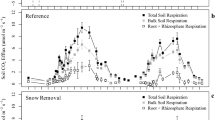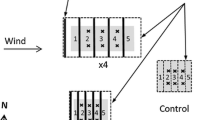Abstract
Snow accumulation can influence soil properties in arctic and alpine tundra, boreal and temperate forests, and temperate grasslands. However, snow may be even more influential in arid ecosystems, which by definition are water limited, such as the hyper-arid polar desert of the McMurdo Dry Valleys, Antarctica. Moreover, snow accumulation may be altered by climate change in the future. In order to investigate the impact of changes in snow accumulation on soils in the McMurdo Dry Valleys we experimentally manipulated the quantity of snow at two locations and monitored soil properties over 5 years in relation to a snow depth gradient created by snow fences. We predicted that increased snow depth would be associated with increased soil moisture and a shift in soil animal community structure. While we did not observe changes in soil biochemistry or community structure along the snow depth gradient at either site, increased snow accumulation caused by the snow fence altered soil properties across the entire length of the transects at one site (Fryxell), which collected substantially more snow than the other site. At Fryxell, the presence of the snow fence increased gravimetric soil moisture from 1 to 5–9%. This was associated with a decline in abundance of the dominant animal, Scottnema lindsayae, a nematode typically found in dry soil, and an increase in Eudorylaimus sp. a nematode associated with moist soil. We also observed changes in soil pH, salinity, and concentrations of inorganic nitrogen and chlorophyll a over the course of the experiment, but it was difficult to determine if these were caused by snow accumulation or simply represented temporal variation related to other factors.









Similar content being viewed by others
References
Adams BJ, Bardgett RD, Ayres E, Wall DH, Aislabie J, Bamforth S, Bargagli R, Cary C, Cavacini P, Connell L, Convey P, Fell JW, Frati F, Hogg ID, Newsham KK, O’Donnell A, Russell N, Seppelt RD, Stevens MI (2006) Diversity and distribution of Victoria Land biota. Soil Biol Biochem 38:3003–3018
Alon A, Steinberger Y (1999) Response of the soil microbial biomass and nematode population to a wetting event in nitrogen-amended Negev desert plots. Biol Fertil Soils 30:147–152
Andrassy I (1998) Nematodes in the sixth continent. J Nematode Morphol Syst 1:107–186
Andrassy I (2008) Eudorylaimus species (Nematoda: Dorylaimida) of continental Antarctica. J Nematode Morphol Syst 11:49–66
Ayres E, Wall DH, Adams BJ, Barrett JE, Virginia RA (2007) Unique similarity of faunal communities across aquatic-terrestrial interfaces in a polar desert ecosystem. Ecosystems 10:523–535
Bakonyi G, Nagy P (2000) Temperature- and moisture-induced changes in the structure of the nematode fauna of a semiarid grassland—patterns and mechanisms. Glob Chang Biol 6:697–707
Bakonyi G, Nagy P, Kovacs-Lang E, Kovacs E, Barabas S, Repasi V, Seres A (2007) Soil nematode community structure as affected by temperature and moisture in a temperate semiarid shrubland. Appl Soil Ecol 37:31–40
Barnett TP, Adam JC, Lettenmaier DP (2005) Potential impacts of a warming climate on water availability in snow-dominated regions. Nature 438:303–309
Barrett JE, Virginia RA, Wall DH (2002) Trends in resin and KCl-extractable soil nitrogen across landscape gradients in Taylor Valley, Antarctica. Ecosystems 5:289–299
Barrett JE, Virginia RA, Wall DH, Parsons AN, Powers LE, Burkins MB (2004) Variation in biogeochemistry and soil biodiversity across spatial scales in a polar desert ecosystem. Ecology 85:3105–3118
Barrett JE, Virginia RA, Lyons WB, McKnight DM, Priscu JC, Doran PT, Fountain AG, Wall DH, Moorhead DL (2007) Biogeochemical stoichiometry of Antarctic Dry Valley ecosystems. J Geophys Res Biogeosci 112:G01010
Barrett JE, Virginia RA, Wall DH, Adams BJ (2008a) Decline in a dominant invertebrate species contributes to altered carbon cycling in a low-diversity soil ecosystem. Glob Chang Biol 14:1–11
Barrett JE, Virginia RA, Wall DH, Doran PT, Fountain AG, Welch KA, Lyons WB (2008b) Persistent effects of a discrete warming event on a polar desert ecosystem. Glob Chang Biol 14:2249–2261
Buckeridge KM, Grogan P (2008) Deepened snow alters soil microbial nutrient limitations in arctic birch hummock tundra. Appl Soil Ecol 39:210–222
Campbell IB (2003) Soil characteristics at a long-term ecological research site in Taylor Valley, Antarctica. Aust J Soil Res 41:351–364
Campbell IB, Claridge GGC (1987) Antarctica: soils, weathering processes and environment. Elsevier, Amsterdam
Cannone N, Wagner D, Hubberten HW, Guglielmin M (2008) Biotic and abiotic factors influencing soil properties across a latitudinal gradient in Victoria Land, Antarctica. Geoderma 144:50–65
Chapman WL, Walsh JE (2007) A synthesis of Antarctic temperatures. J Clim 20:4096–4117
Chinn TH (1993) Physical hydrology of the dry valley lakes. In: Green WJ, Friedmann EI (eds) Physical and biogeochemical processes in Antarctic lakes. American Geophysical Union, Washington, DC, pp 1–51
Coiro MI, Sasanelli N, Serino M (1995) Fecundity and longevity of individual Xiphinema ifacolum (Nematoda, Dorylaimidae) on tomato. Nematologica 41:191–196
Connell L, Redman R, Craig S, Rodriguez R (2006) Distribution and abundance of fungi in the soils of Taylor Valley, Antarctica. Soil Biol Biochem 38:3083–3094
Doran PT, McKay CP, Clow GD, Dana GL, Fountain AG, Nylen T, Lyons WB (2002a) Valley floor climate observations from the McMurdo dry valleys, Antarctica, 1986–2000. J Geophys Res Atmos 107:4772
Doran PT, Priscu JC, Lyons WB, Walsh JE, Fountain AG, McKnight DM, Moorhead DL, Virginia RA, Wall DH, Clow GD, Fritsen CH, McKay CP, Parsons AN (2002b) Antarctic climate cooling and terrestrial ecosystem response. Nature 415:517–520
Elberling B, Gregorich EG, Hopkins DW, Sparrow AD, Novis P, Greenfield LG (2006) Distribution and dynamics of soil organic matter in an Antarctic dry valley. Soil Biol Biochem 38:3095–3106
Fell JW, Scorzetti G, Connell L, Craig S (2006) Biodiversity of micro-eukaryotes in Antarctic Dry Valley soils with <5% soil moisture. Soil Biol Biochem 38:3107–3119
Foreman CM, Wolf CF, Priscu JC (2004) Impact of episodic warming events on the physical, chemical and biological relationships of lakes in the McMurdo Dry Valleys, Antarctica. Aquat Geochem 10:239–268
Fountain AG, Lyons WB, Burkins MB, Dana GL, Doran PT, Lewis KJ, McKnight DM, Moorhead DL, Parsons AN, Priscu JC, Wall DH, Wharton RA, Virginia RA (1999) Physical controls on the Taylor Valley ecosystem, Antarctica. Bioscience 49:961–971
Fountain AG, Nylen TH, Monaghan A, Basagic HJ, Bromwich D (2009) Snow in the McMurdo Dry Valleys, Antarctica. Int J Climatol. doi:10.1002/joc.1933
Freckman DW, Virginia RA (1993) Extraction of nematodes from Dry Valley Antarctic soils. Polar Biol 13:483–487
Freckman DW, Virginia RA (1997) Low-diversity Antarctic soil nematode communities: distribution and response to disturbance. Ecology 78:363–369
Freckman DW, Virginia RA (1998) Soil biodiversity and community structure in the McMurdo Dry Valleys, Antarctica. In: Priscu JC (ed) Ecosystem dynamics in a polar desert: the McMurdo Dry Valleys, Antarctica. American Geophysical Union, Washington, DC, pp 323–335
Freckman DW, Whitford WG, Steinberger Y (1987) Effect of irrigation on nematode population-dynamics and activity in desert soils. Biol Fertil Soils 3:3–10
Gooseff MN, Barrett JE, Doran PT, Fountain AG, Lyons WB, Parsons AN, Porazinska DL, Virginia RA, Wall DH (2003) Snow-patch influence on soil biogeochemical processes and invertebrate distribution in the McMurdo Dry Valleys, Antarctica. Arct Antarc Alp Res 35:91–99
Grippa M, Kergoat L, Le Toan T, Mognard NM, Delbart N, L’Hermitte J, Vicente-Serrano SM (2005) The impact of snow depth and snowmelt on the vegetation variability over central Siberia. Geophys Res Lett 32:L21412
Groffman PM, Driscoll CT, Fahey TJ, Hardy JP, Fitzhugh RD, Tierney GL (2001) Effects of mild winter freezing on soil nitrogen and carbon dynamics in a northern hardwood forest. Biogeochemistry 56:191–213
Groffman PM, Hardy JP, Driscoll CT, Fahey TJ (2006) Snow depth, soil freezing, and fluxes of carbon dioxide, nitrous oxide and methane in a northern hardwood forest. Glob Chang Biol 12:1748–1760
IPCC (2007) Fourth assessment report: climate change 2007. Cambridge University Press, Cambridge
Kaste O, Austnes K, Vestgarden LS, Wright RF (2008) Manipulation of snow in small headwater catchments at Storgama, Norway: effects on leaching of inorganic nitrogen. Ambio 37:29–37
Kennedy AD (1993) Water as a limiting factor in the Antarctic terrestrial environment—a biogeographical synthesis. Arct Alp Res 25:308–315
Moorhead DL, Barrett JE, Virginia RA, Wall DH, Porazinska D (2003) Organic matter and soil biota of upland wetlands in Taylor Valley, Antarctica. Polar Biol 26:567–576
Mote PW, Hamlet AF, Clark MP, Lettenmaier DP (2005) Declining mountain snowpack in western north America. Bull Am Meteorol Soc 86:39
Nylen TH, Fountain AG, Doran PT (2004) Climatology of katabatic winds in the McMurdo dry valleys, southern Victoria Land, Antarctica. J Geophys Res Atmos 109:D03114
Overhoff A, Freckman DW, Virginia RA (1993) Life cycle of the microbivorous Antarctic Dry Valley nematode Scottnema lindsayae (Timm 1971). Polar Biol 13:151–156
Poage MA, Barrettt JE, Virginia RA, Wall DH (2008) The influence of soil geochemistry on nematode distribution, McMurdo Dry Valleys, Antarctica. Arct Antarc Alp Res 40:119–128
Porazinska DL, Wall DH, Virginia RA (2002) Population age structure of nematodes in the Antarctic Dry Valleys: perspectives on time, space, and habitat suitability. Arct Antarc Alp Res 34:159–168
Powers LE, Freckman DW, Virginia RA (1995) Spatial distribution of nematodes in polar desert soils of Antarctica. Polar Biol 15:325–333
Powers LE, Ho MC, Freckman DW, Virginia RA (1998) Distribution, community structure, and microhabitats of soil invertebrates along an elevational gradient in Taylor Valley, Antarctica. Arct Alp Res 30:133–141
Schimel JP, Bilbrough C, Welker JA (2004) Increased snow depth affects microbial activity and nitrogen mineralization in two Arctic tundra communities. Soil Biol Biochem 36:217–227
Schwarz AMJ, Green TGA, Seppelt RD (1992) Terrestrial vegetation at Canada Glacier, Southern Victoria Land, Antarctica. Polar Biol 12:397–404
Simmons BL, Wall DH, Adams BJ, Ayres E, Barrett JE, Virginia RA (2009) Long-term experimental warming reduces soil nematode populations in the McMurdo Dry Valleys, Antarctica. Soil Biol Biochem 41:2052–2060
Stevens MI, Hogg ID (2002) Expanded distributional records of Collembola and Acari in southern Victoria land, Antarctica. Pedobiologia 46:485–495
Treonis AM, Wall DH, Virginia RA (1999) Invertebrate biodiversity in Antarctic dry valley soils and sediments. Ecosystems 2:482–492
Treonis AM, Wall DH, Virginia RA (2000) The use of anhydrobiosis by soil nematodes in the Antarctic Dry Valleys. Funct Ecol 14:460–467
Ugolini FC, Bockheim JG (2008) Antarctic soils and soil formation in a changing environment: a review. Geoderma 144:1–8
Walker MD, Walker DA, Welker JM, Arft AM, Bardsley T, Brooks PD, Fahnestock JT, Jones MH, Losleben M, Parsons AN, Seastedt TR, Turner PL (1999) Long-term experimental manipulation of winter snow regime and summer temperature in arctic and alpine tundra. Hydrol Process 13:2315–2330
Wall DH (2007) Global change tipping points: above- and below-ground biotic interactions in a low diversity ecosystem. Philos Trans R Soc B Biol Sci 362:2291–2306
Wipf S, Rixen C, Mulder CPH (2006) Advanced snowmelt causes shift towards positive neighbour interactions in a subarctic tundra community. Glob Chang Biol 12:1496–1506
Acknowledgments
Snow depth and density measurements were performed by Thomas Nylen and Hassan Basagic. Steve Blecker, Holley Zadeh, Claire Ojima, Andy Parsons, Dorota Porazinska, and Emma Broos assisted with soil sample collection and processing. This study was supported by National Science Foundation grants OPP 9810219 and OPP 0096250 as part of the McMurdo Dry Valley LTER.
Author information
Authors and Affiliations
Corresponding author
Rights and permissions
About this article
Cite this article
Ayres, E., Nkem, J.N., Wall, D.H. et al. Experimentally increased snow accumulation alters soil moisture and animal community structure in a polar desert. Polar Biol 33, 897–907 (2010). https://doi.org/10.1007/s00300-010-0766-3
Received:
Revised:
Accepted:
Published:
Issue Date:
DOI: https://doi.org/10.1007/s00300-010-0766-3




